In commemoration of the last known Cascadia subduction zone earthquake, I present a summary background material here. Since last years commemoration, there have been a few additions.
I made some updates on 2018.01.26.
Most notably was a pair of articles that were published in the New Yorker magazine, written by Kathryn Shulz. The first article summarized what we might expect from a CSZ earthquake and tsunami and the follow-up article discussed how to best prepare for this series of devastating events. The first article sparked a national debate after it was read by millions (using an estimate based upon the recorded time the website was being used). This debate has resulted in a renewed interest in becoming more resilient.
-
Here are the two articles.
- 2015.07.20
- 2015.07.28
On this evening, 316 years ago, the Cascadia subduction zone fault ruptured as a margin wide earthquake. I here commemorate this birthday with some figures that are in two USGS open source professional papers. The Atwater et al. (2005) paper discusses how we came to the conclusion that this last full margin earthquake happened on January 26, 1700 at about 9 PM (there may have been other large magnitude earthquakes in Cascadia in the 19th century). The Goldfinger et al. (2012) paper discusses how we have concluded that the records from terrestrial paleoseismology are correlable and how we think that the margin may have ruptured in the past (rupture patch sizes and timing). The reference list is extensive and this is but a tiny snapshot of what we have learned about Cascadia subduction zone earthquakes. Brian Atwater and his colleagues have updated the Orphan Tsunami and produced a second edition available here for download and here for hard copy purchase (I have a hard copy).

This is a video from NOVA with the great Dr. Brian Atwater.
Here is a map of the Cascadia subduction zone, modified from Nelson et al. (2006). The Juan de Fuca and Gorda plates subduct norteastwardly beneath the North America plate at rates ranging from 29- to 45-mm/yr. Sites where evidence of past earthquakes (paleoseismology) are denoted by white dots. Where there is also evidence for past CSZ tsunami, there are black dots. These paleoseismology sites are labeled (e.g. Humboldt Bay). Some submarine paleoseismology core sites are also shown as grey dots. The two main spreading ridges are not labeled, but the northern one is the Juan de Fuca ridge (where oceanic crust is formed for the Juan de Fuca plate) and the southern one is the Gorda rise (where the oceanic crust is formed for the Gorda plate).
- The USGS produces model based estimates for ground shaking using a variety of measures, for “scenario” earthquakes. Here is their website that explains this further. Below I present one of these scenarios, one for a M 9.0 CSZ eaarthquake. This is possibly what it was like for the last full rip CSZ earthquake on 1700.01.26.
USGS Shake Map M 9.0 Scenario Poster
- In celebration of the anniversary in 2018, I prepared a new educational poster, which is based upon the above scenario shakemap.
- I include some inset figures.
- In the upper left corner is a map of the Cascadia subduction zone, modified from Nelson et al. (2004) and Chaytor et al. (2004).
- Below the CSZ map is an illustration modified from Plafker (1972). This figure shows how a subduction zone deforms between (interseismic) and during (coseismic) earthquakes.
- In the lower right corner is a figure from Atwater et al. (2005) that shows the earthquake cycle and how the crust deforms at different times.
- On the left is the overall setting, where one plate subducts beneath another one at this compressional (convergent) plate boundary.
- The center panel represents the interseismic period, the time between earthquakes. The fault is locked. The downgoing plate causes elastic strain to accumulate along the fault and in the two plates. The upper plate deforms vertically because of this. The region closest to the fault tip (the left) goes down and the part further from the fault tip goes up.
- The right panel represents the coseismic period, when the earthquake happens. When the fault slips (in addition to some time before and after the earthquake), the upper plate deforms in an opposite sense of motion. This is the conventional view, but some say that because this system is not solely elastic (the mantle behaves with viscoelastic properties; Wang and Trehu, 2017).
- Above this lower right corner figure is a figure from Atwater et al. (2005) that shows (A) how the vertical land motion produces earthquake stratigraphy in the form of buried soils (the trees died, so sad) and (B) a photo showing these buried soils, including a real dead tree stump (so sad).
- In the upper right corner is a diagram that shows how we think the CSZ fault is segmented. Each segment is designated by an orange arrow. These orange arrows represent the region of the fault that has ruptured at different times. This is based upon turbidite stratigraphic correlations (Goldfinger et al., 2003, 2012, 2016). The yellow numbers represent the average time between earthquakes for each of these segments.
Dr. Nick Zentner (Central Washington Univ.) Video
- CWU’s Nick Zentner presents ‘Great Earthquakes of the Pacific Northweset’ – the 13th talk in his ongoing Downtown Geology Lecture Series. Recorded at Hal Holmes Center on February 10, 2016 in Ellensburg, Washington, USA. www.nickzentner.com
IRIS / USGS Video
IRIS and the US Geological Survey have recently produced an educational video about tectonic earthquakes in the region of the US Pacific Northwest. The project was funded by the National Science Foundation.
YT link for the embedded video below.
mp4 link for the embedded video below.
mp4 embedded video:
YT embedded video:
- Hemphill-Haley, E., 1995. Diatom evidence for earthquake-induced subsidence and tsunami 300 yr ago in southern coastal Washington in GSA Bulletin, v. 107, p. 367-378.
- Nelson, A.R., Shennan, I., and Long, A.J., 1996. Identifying coseismic subsidence in tidal-wetland stratigraphic sequences at the Cascadia subduction zone of western North America in Journal of Geophysical Research, v. 101, p. 6115-6135.
- Atwater, B.F. and Hemphill-Haley, E., 1997. Recurrence Intervals for Great Earthquakes of the Past 3,500 Years at Northeastern Willapa Bay, Washington in U.S. Geological Survey Professional Paper 1576, Washington D.C., 119 pp.
I have compiled some literature about the CSZ earthquake and tsunami. Here is a short list that might help us learn about what is contained within the core that I collected.
Some Relevant Discussion and Figures
This figure shows how a subduction zone deforms between (interseismic) and during (coseismic) earthquakes. We also can see how a subduction zone generates a tsunami. Atwater et al., 2005.
Here is a version of the CSZ cross section alone (Plafker, 1972).
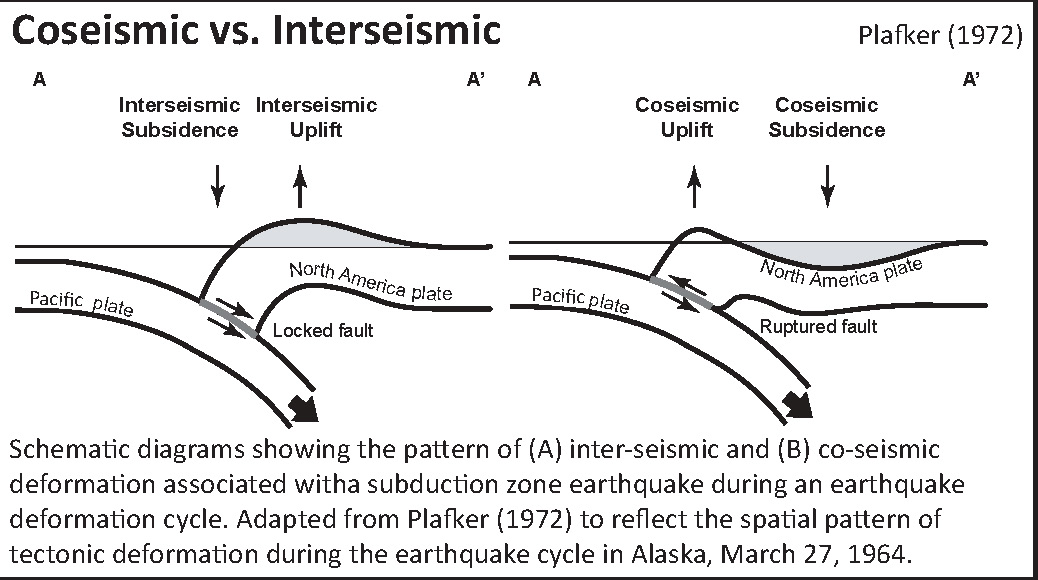
Here is an animation produced by the folks at Cal Tech following the 2004 Sumatra-Andaman subduction zone earthquake. I have several posts about that earthquake here and here. One may learn more about this animation, as well as download this animation here.
This figure shows the regions that participate in this interseismic and coseismic deformation at Cascadia. Atwater et al., 2005. Black dots on the map show sites where evidence for coseismic subsidence has been found in coastal marshes, lakes, and estuaries.
This shows how the CSZ is deforming vertically today (Wang et al., 2003). The panel on the right shows the vertical motion in mm/yr.
This figure, also from Wang et al. (2003), shows their estimate of how the coseismic vertical motion may happen. Contours are in meters.
Here is a graphic showing the sediment-stratigraphic evidence of earthquakes in Cascadia. Atwater et al., 2005. There are 3 panels on the left, showing times of (1) prior to earthquake, (2) several years following the earthquake, and (3) centuries after the earthquake. Before the earthquake, the ground is sufficiently above sea level that trees can grow without fear of being inundated with salt water. During the earthquake, the ground subsides (lowers) so that the area is now inundated during high tides. The salt water kills the trees and other plants. Tidal sediment (like mud) starts to be deposited above the pre-earthquake ground surface. This sediment has organisms within it that reflect the tidal environment. Eventually, the sediment builds up and the crust deforms interseismically until the ground surface is again above sea level. Now plants that can survive in this environment start growing again. There are stumps and tree snags that were rooted in the pre-earthquake soil that can be used to estimate the age of the earthquake using radiocarbon age determinations. The tree snags form “ghost forests.
Here is a photo of the ghost forest, created from coseismic subsidence during the Jan. 26, 1700 Cascadia subduction zone earthquake. Atwater et al., 2005.
Here is a photo I took in Alaska, where there was a subduction zone earthquake in 1964. These tree snags were living trees prior to the earthquake and remain to remind us of the earthquake hazards along subduction zones.

This shows how a tsunami deposit may be preserved in the sediment stratigraphy following a subduction zone earthquake, like in Cascadia. Atwater et al., 2005. If there is a source of sediment to be transported by a tsunami, it will come along for the ride and possibly be deposited upon the pre-earthquake ground surface. Following the earthquake, tidal sediment is deposited above the tsunami transported sediment. Sometimes plants that were growing prior to the earthquake get entombed within the tsunami deposit.
The NOAA/NWS/Pacific Tsunami Warning Center has updated their animation of the simulation of the 1700 “Orphan Tsunami.”
Source: Nathan C. Becker, Ph.D. nathan.becker at noaa.gov
Below are some links and embedded videos.
- Here is the yt link for the embedded video below.
- Here is the mp4 link for the embedded video below. (1080p 145 mb mp4)
- 1700.09.26 M 9.0 Cascadia’s 315th Anniversary 2015.01.26
- 1700.09.26 M 9.0 Cascadia’s 316th Anniversary 2016.01.26 (this page)
- 1992.04.25 M 7.1 Cape Mendocino 25 year remembrance
- 1992.04.25 M 7.1 Cape Mendocino 25 Year Remembrance Event Page
- Earthquake Information about the CSZ 2015.10.08
- 2017.07.28 M 5.1 Gorda plate
- 2016.09.25 M 5.0 Gorda plate
- 2016.09.25 M 5.0 Gorda plate
- 2016.01.30 M 5.0 Gorda plate
- 2015.12.29 M 4.9 Gorda plate
- 2015.11.18 M 3.2 Gorda plate
- 2014.03.13 M 5.2 Gorda Rise
- 2014.03.09 M 6.8 Gorda plate p-1
- 2014.03.23 M 6.8 Gorda plate p-2
- 2015.06.01 M 5.8 Blanco fracture zone p-1
- 2015.06.01 M 5.8 Blanco fracture zone p-2 (animations)
- 2018.01.25 M 5.8 Mendocino fault
- 2017.09.22 M 5.7 Mendocino fault
- 2016.12.08 M 6.5 Mendocino fault, CA
- 2016.12.08 M 6.5 Mendocino fault, CA Update #1
- 2016.12.05 M 4.3 Petrolia CA
- 2016.10.27 M 4.1 Mendocino fault
- 2016.09.03 M 5.6 Mendocino
- 2016.01.02 M 4.5 Mendocino fault
- 2015.11.01 M 4.3 Mendocino fault
- 2015.01.28 M 5.7 Mendocino fault
- 2017.03.06 M 4.0 Cape Mendocino
- 2016.11.02 M 3.6 Oregon
- 2016.01.07 M 4.2 NAP(?)
- 2015.10.29 M 3.4 Bayside
- 2017.01.07 M 5.7 Explorer plate
- 2016.03.19 M 5.2 Explorer plate
- 2017.06.11 M 3.5 Gorda or NAP?
- 2016.07.21 M 4.7 Gorda or NAP? p-1
- 2016.07.21 M 4.7 Gorda or NAP? p-2
Here is the text associated with this animation:
Just before midnight on January 27, 1700 a tsunami struck the coasts of Japan without warning since no one in Japan felt the earthquake that must have caused it. Nearly 300 years later scientists and historians in Japan and the United States solved the mystery of what caused this “orphan tsunami” through careful analysis of historical records in Japan as well as oral histories of Native Americans, sediment deposits, and ghost forests of drowned trees in the Pacific Northwest of North America, a region also known as Cascadia. They learned that this geologically active region, the Cascadia Subduction Zone, not only hosts erupting volcanoes but also produces megathrust earthquakes capable of generating devastating, ocean-crossing tsunamis. By comparing the tree rings of dead trees with those still living they could tell when the last of these great earthquakes struck the region. The trees all died in the winter of 1699-1700 when the coasts of northern California, Oregon, and Washington suddenly dropped 1-2 m (3-6 ft.), flooding them with seawater. That much motion over such a large area requires a very large earthquake to explain it—perhaps as large as 9.2 magnitude, comparable to the Great Alaska Earthquake of 1964. Such an earthquake would have ruptured the earth along the entire length of the 1000 km (600 mi) -long fault of the Cascadia Subduction Zone and severe shaking could have lasted for 5 minutes or longer. Its tsunami would cross the Pacific Ocean and reach Japan in about 9 hours, so the earthquake must have occurred around 9 o’clock at night in Cascadia on January 26, 1700 (05:00 January 27 UTC).
The Pacific Tsunami Warning Center (PTWC) can create an animation of a historical tsunami like this one using the same too that they use for determining tsunami hazard in real time for any tsunami today: the Real-Time Forecasting of Tsunamis (RIFT) forecast model. The RIFT model takes earthquake information as input and calculates how the waves move through the world’s oceans, predicting their speed, wavelength, and amplitude. This animation shows these values through the simulated motion of the waves and as they race around the globe one can also see the distance between successive wave crests (wavelength) as well as their height (half-amplitude) indicated by their color. More importantly, the model also shows what happens when these tsunami waves strike land, the very information that PTWC needs to issue tsunami hazard guidance for impacted coastlines. From the beginning the animation shows all coastlines covered by colored points. These are initially a blue color like the undisturbed ocean to indicate normal sea level, but as the tsunami waves reach them they will change color to represent the height of the waves coming ashore, and often these values are higher than they were in the deeper waters offshore. The color scheme is based on PTWC’s warning criteria, with blue-to-green representing no hazard (less than 30 cm or ~1 ft.), yellow-to-orange indicating low hazard with a stay-off-the-beach recommendation (30 to 100 cm or ~1 to 3 ft.), light red-to-bright red indicating significant hazard requiring evacuation (1 to 3 m or ~3 to 10 ft.), and dark red indicating a severe hazard possibly requiring a second-tier evacuation (greater than 3 m or ~10 ft.).
Toward the end of this simulated 24-hours of activity the wave animation will transition to the “energy map” of a mathematical surface representing the maximum rise in sea-level on the open ocean caused by the tsunami, a pattern that indicates that the kinetic energy of the tsunami was not distributed evenly across the oceans but instead forms a highly directional “beam” such that the tsunami was far more severe in the middle of the “beam” of energy than on its sides. This pattern also generally correlates to the coastal impacts; note how those coastlines directly in the “beam” have a much higher impact than those to either side of it.
This is the timeline of prehistoric earthquakes as preserved in sediment stratigraphy in Grays Harbor and Willapa Bay, Washington. Atwater et al., 2005. This timeline is based upon numerous radiocarbon age determinations for materials that died close to the time of the prehistoric earthquakes inferred from the sediment stratigraphy at locations along the Grays Harbor, Willapa Bay, and Columbia River estuary paleoseismic sites.
Offshore, Goldfinger and others (from the 1960’s into the 21st Century, see references in Goldfinger et al., 2012) collected cores in the deep sea. These cores contain submarine landslide deposits (called turbidites). These turbidites are thought to have been deposited as a result of strong ground shaking from large magnitude earthquakes. Goldfinger et al. (2012) compile their research in the USGS professional paper. This map shows where the cores are located.
Here is an example of how these “seismoturbidites” have been correlated. The correlations are the basis for the interpretation that these submarine landslides were triggered by Cascadia subduction zone earthquakes. This correlation figure demonstrates how well these turbidites have been correlated. Goldfinger et al., 2012
This map shows the various possible prehistoric earthquake rupture regions (patches) for the past 10,000 years. Goldfinger et al., 2012. These rupture scenarios have been adopted by the USGS hazards team that determines the seismic hazards for the USA.
Here is a plot showing the earthquakes in a linear timescale.

I combined the plot above into another figure that includes all the recurrence intervals and segment lengths in a single figure. This is modified from Goldfinger et al. (2012), updated from new data (Goldfinger et al., 2016).

Social Media (2018 addition)
Today is the 318th anniversary of the Cascadia #earthquake of 1700. How do we know about #Cascadia's ancient earthquakes? Watch this video to find out! | VIDEO (00:03:54) Ghost Forests of the Pacific N.W.—Evidence for Cascadia's Past Earthquakes https://t.co/u6RcP9pMeN pic.twitter.com/RUSUWDQZSx
— IRIS Earthquake Sci (@IRIS_EPO) January 26, 2018
New post about The M9 Project and 3-D computer simulations on our blog! https://t.co/8ZHeO9vYe3 pic.twitter.com/MQnybJnp06
— PNSN (@PNSN1) January 27, 2018
Viola Riebe, elder of the Hoh Indian Tribe, talks about an oral history of the Thunderbird and the whale — and how this most respected story is related to tsunami awareness. “We’re told in our language to run for high ground to get away from the ocean because it’s dangerous,” she says.
and here's a good piece from Hakai that summarizes some of the indigenous accounts in greater detail: https://t.co/NLeRySpTCA
— Elizabeth Angell (@kitabet) January 27, 2018
Cascadia subduction zone Earthquake Reports
General Overview
Earthquake Reports
Gorda plate
Blanco fracture zone
Mendocino fault
Mendocino triple junction
North America plate
Explorer plate
Uncertain
Here is the Chaytor et al. (2004) map that shows their interpretation of the structural relations in the Gorda plate.
Here is a map from Rollins and Stein, showing their interpretations of different historic earthquakes in the region. This was published in response to the Januray 2010 Gorda plate earthquake. The faults are from Chaytor et al. (2004).
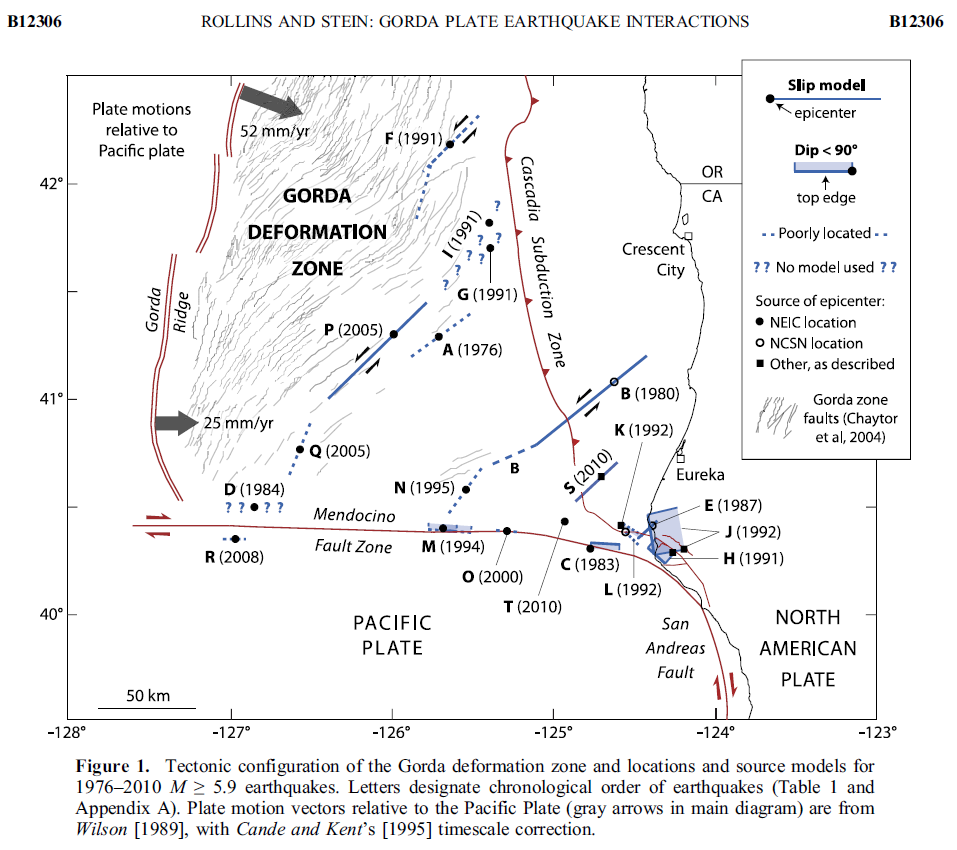
The Blanco fracture zone is also an active transform plate boundary. The BFZ is a strike slip fault system that connects two spreading ridges, the Gorda Rise and the Juan de Fuca Ridge. Here is a map that shows the tectonic setting and some earthquakes related to the BFZ from April 2015. There are some animations on this web page showing seismicity with time along the BFZ, over the past 15
years.
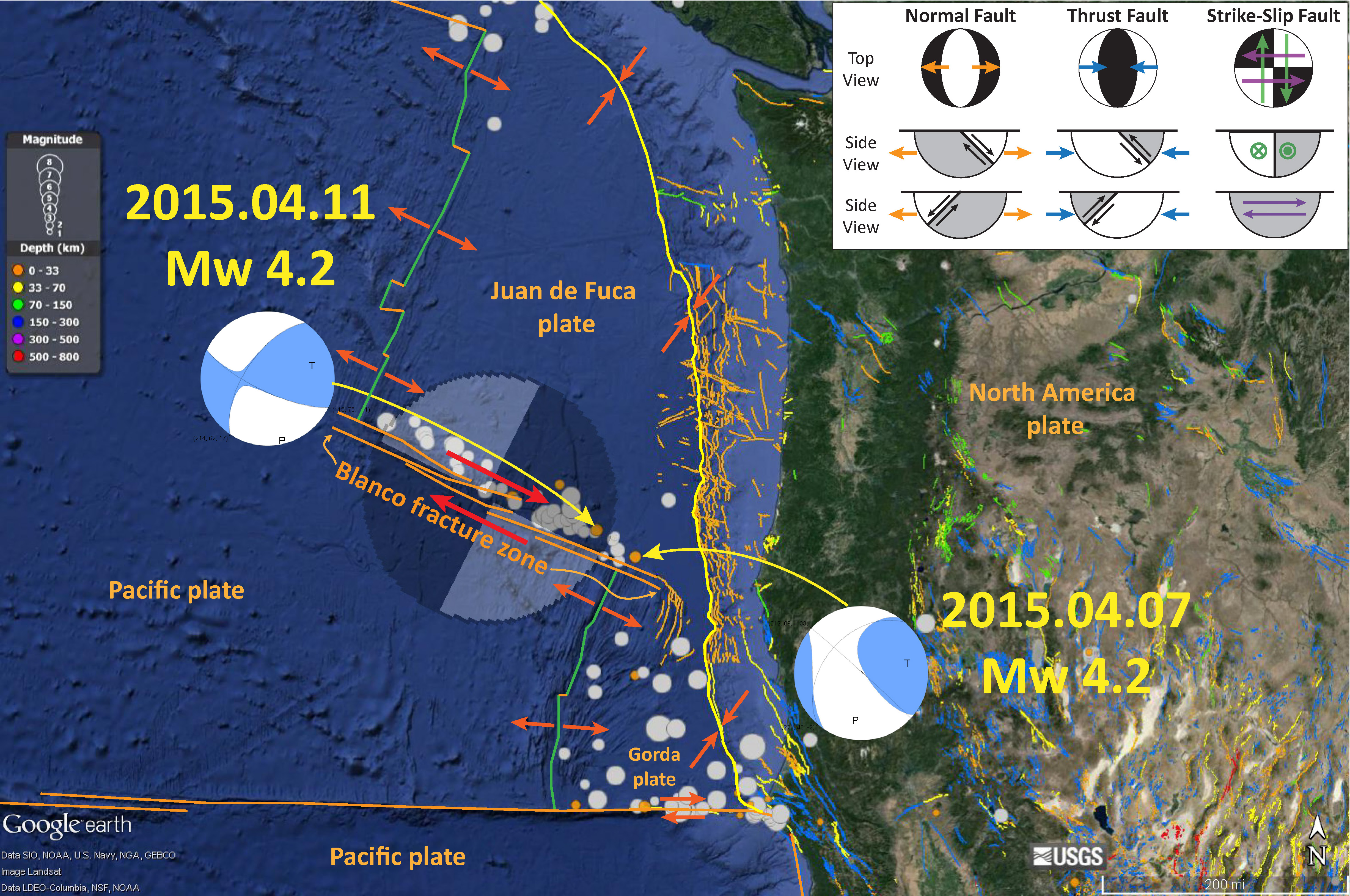
- Atwater, B.F., Musumi-Rokkaku, S., Satake, K., Tsuju, Y., Eueda, K., and Yamaguchi, D.K., 2005. The Orphan Tsunami of 1700—Japanese Clues to a Parent Earthquake in North America, USGS Professional Paper 1707, USGS, Reston, VA, 144 pp.
- Goldfinger, C., Nelson, C.H., Morey, A., Johnson, J.E., Gutierrez-Pastor, J., Eriksson, A.T., Karabanov, E., Patton, J., Gràcia, E., Enkin, R., Dallimore, A., Dunhill, G., and Vallier, T., 2012 a. Turbidite Event History: Methods and Implications for Holocene Paleoseismicity of the Cascadia Subduction Zone, USGS Professional Paper # 1661F. U.S. Geological Survey, Reston, VA, 184 pp.
- Chris Goldfinger, Steve Galer, Jeffrey Beeson, Tark Hamilton, Bran Black, Chris Romsos, Jason Patton, C Hans Nelson, Rachel Hausmann, Ann Morey, 2016. The importance of site selection, sediment supply, and hydrodynamics: A case study of submarine paleoseismology on the northern Cascadia margin, Washington USA in Marine Geology, v. 384, https://doi.org/10.1016/j.margeo.2016.06.008
- McCrory, P.A., 2000, Upper plate contraction north of the migrating Mendocino triple junction, northern California: Implications for partitioning of strain: Tectonics, v. 19, p. 11441160.
- McCrory, P. A., Blair, J. L., Oppenheimer, D. H., and Walter, S. R., 2006, Depth to the Juan de Fuca slab beneath the Cascadia subduction margin; a 3-D model for sorting earthquakes U. S. Geological Survey
- Nelson, A.R., Kelsey, H.M., Witter, R.C., 2006. Great earthquakes of variable magnitude at the Cascadia subduction zone. Quaternary Research 65, 354-365.
- Patton, J. R., Goldfinger, C., Morey, A. E., Romsos, C., Black, B., Djadjadihardja, Y., and Udrekh, 2013. Seismoturbidite record as preserved at core sites at the Cascadia and Sumatra–Andaman subduction zones, Nat. Hazards Earth Syst. Sci., 13, 833-867, doi:10.5194/nhess-13-833-2013, 2013.
- Plafker, G., 1972. Alaskan earthquake of 1964 and Chilean earthquake of 1960: Implications for arc tectonics in Journal of Geophysical Research, v. 77, p. 901-925.
- Wang, K., Wells, R., Mazzotti, S., Hyndman, R. D., and Sagiya, T., 2003, A revised dislocation model of interseismic deformation of the Cascadia subduction zone Journal of Geophysical Research, B, Solid Earth and Planets v. 108, no. 1.
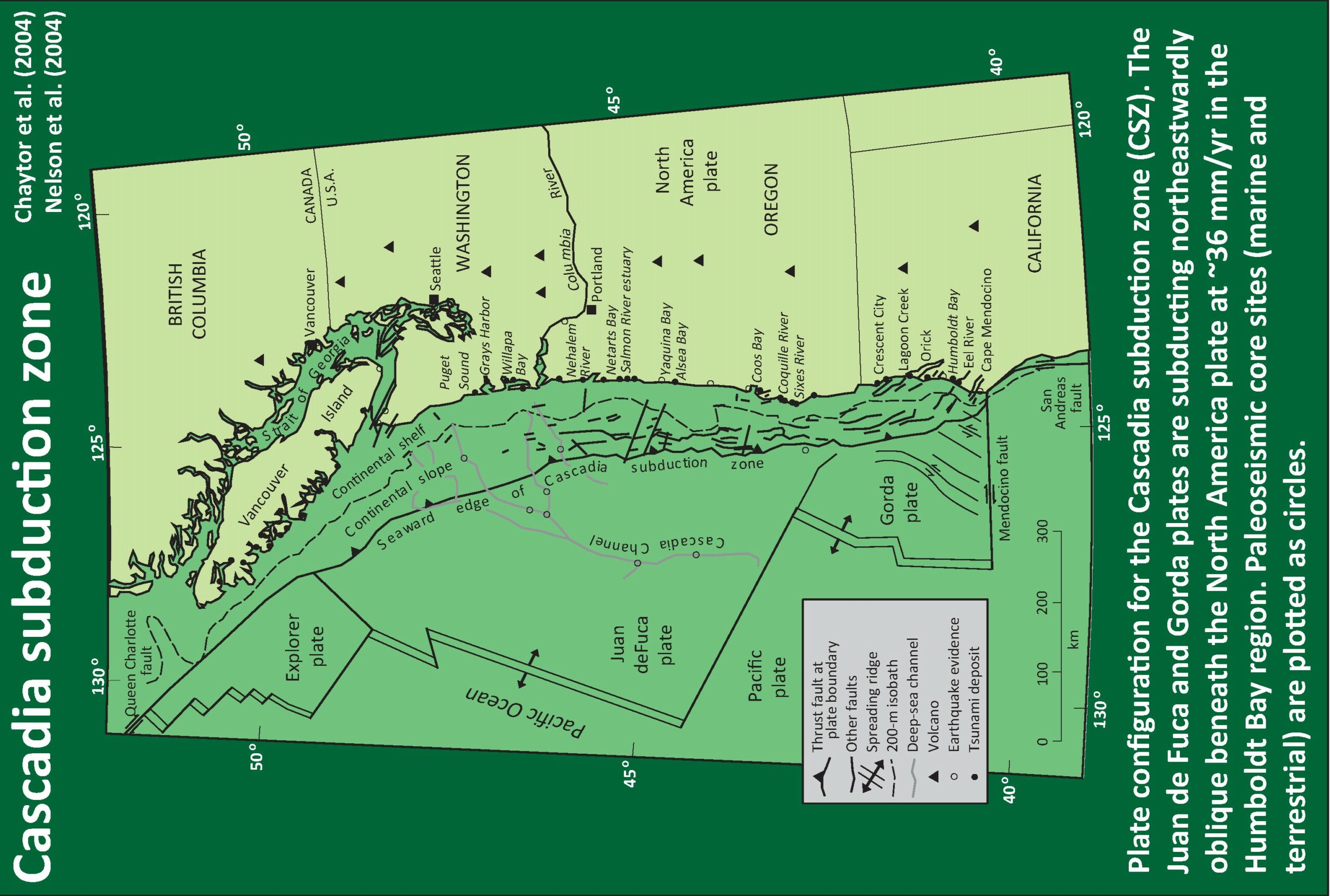
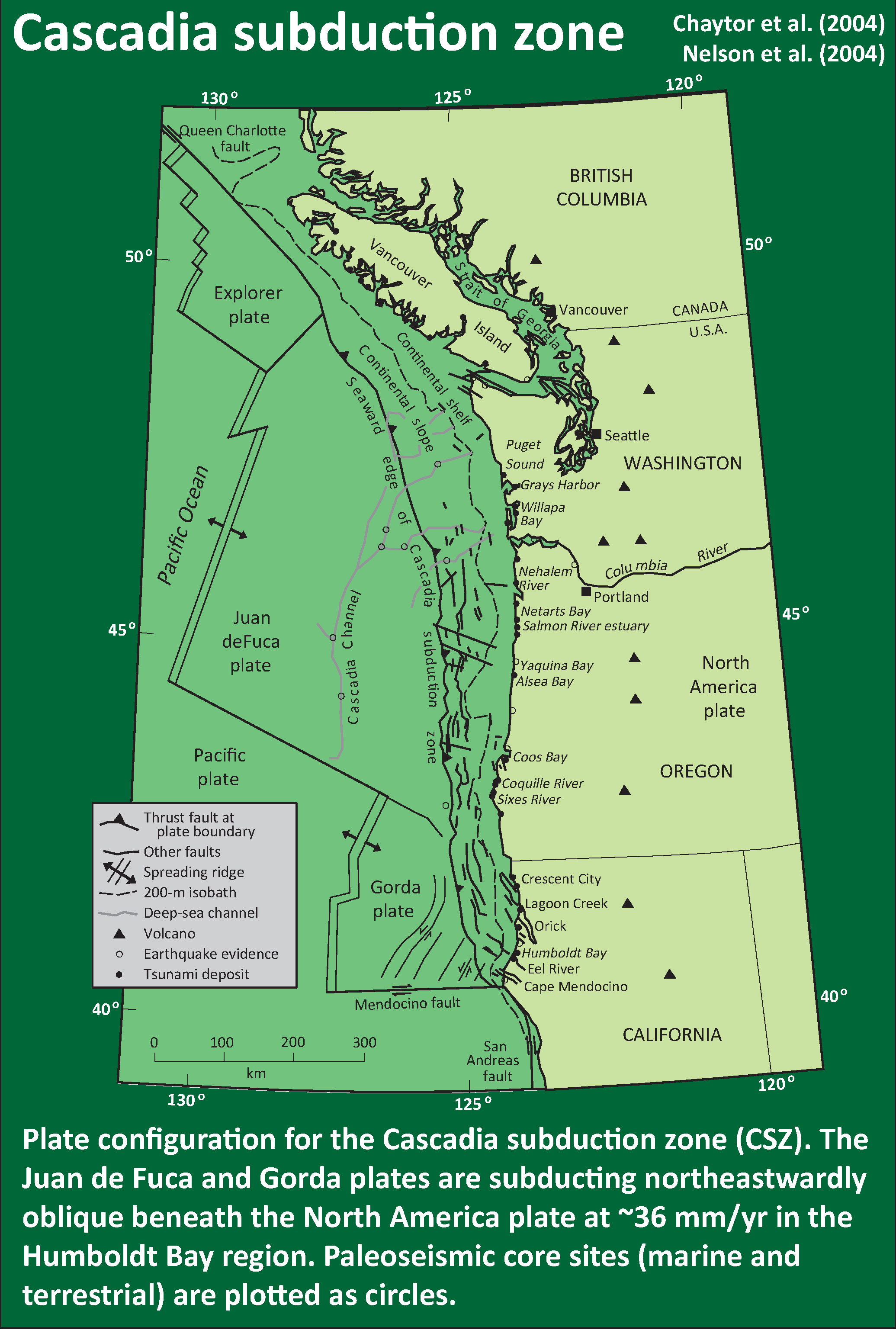


So cool that the can even estimate the time of day it happened.
#amazing
Memorandum deserves a medallion. Happy birthday!
Very comprehensive and very sobering post–thanks for this!
How many years before1700 did the previous one occur?
about 200 years…
here is the time series for the past 10,000 years. each of these earthquakes ruptured the southern part of the subduction zone…
http://media.oregonlive.com/pacific-northwest-news/photo/cascadia-earthquake-timelinejpg-66b5281e5bb09845.jpg
that is a figure that shows all the segment lengths and the mean return period for each of them…
Is this a reasonable statement: We’re past due, and when it happens it’s likely to be one of the CSZ’s larger events.
it is reasonable to say that we are past due here in northern CA (but not in WA). the difference between a mid 8 and a 9 won’t implicate us here because the difference in magnitude is based on the difference in rupture length (how far north-south the earthquake is). so, the ground shaking and tsunami size would be the same here regardless. so for us, it is about the “when.”
Makes sense. Thanks. I live in an area in the hills that were described to me by a geologist (Tom Stephens) as “ancient sand dunes.” I always wonder what that means for building survival relative to other places in the area.
do you live east and above mckinleyville? tom was a brilliant geologist..
depending upon how thick (or saturated at the time) the sand is, it could be more ground shaking…
Yes, Arthur Rd.. Actually bought this place from Tom.
that is the one place that i know of sand dunes that are not near the modern ocean
Raised up due to the subduction?
yes
the faults in the north america plate deform due to the subduction zone… those faults caused the uplift…
Surprised they’re only here, considering the length of the subduction zone.
I should have said locally… there are extensive uplifted dunes in oregon…
OK, sure.